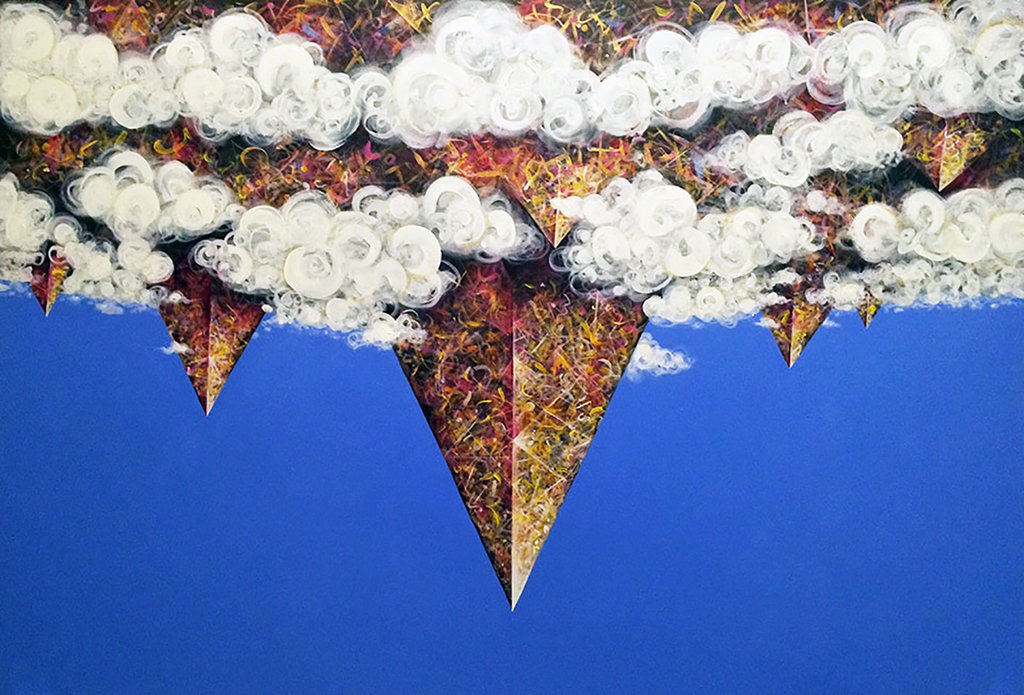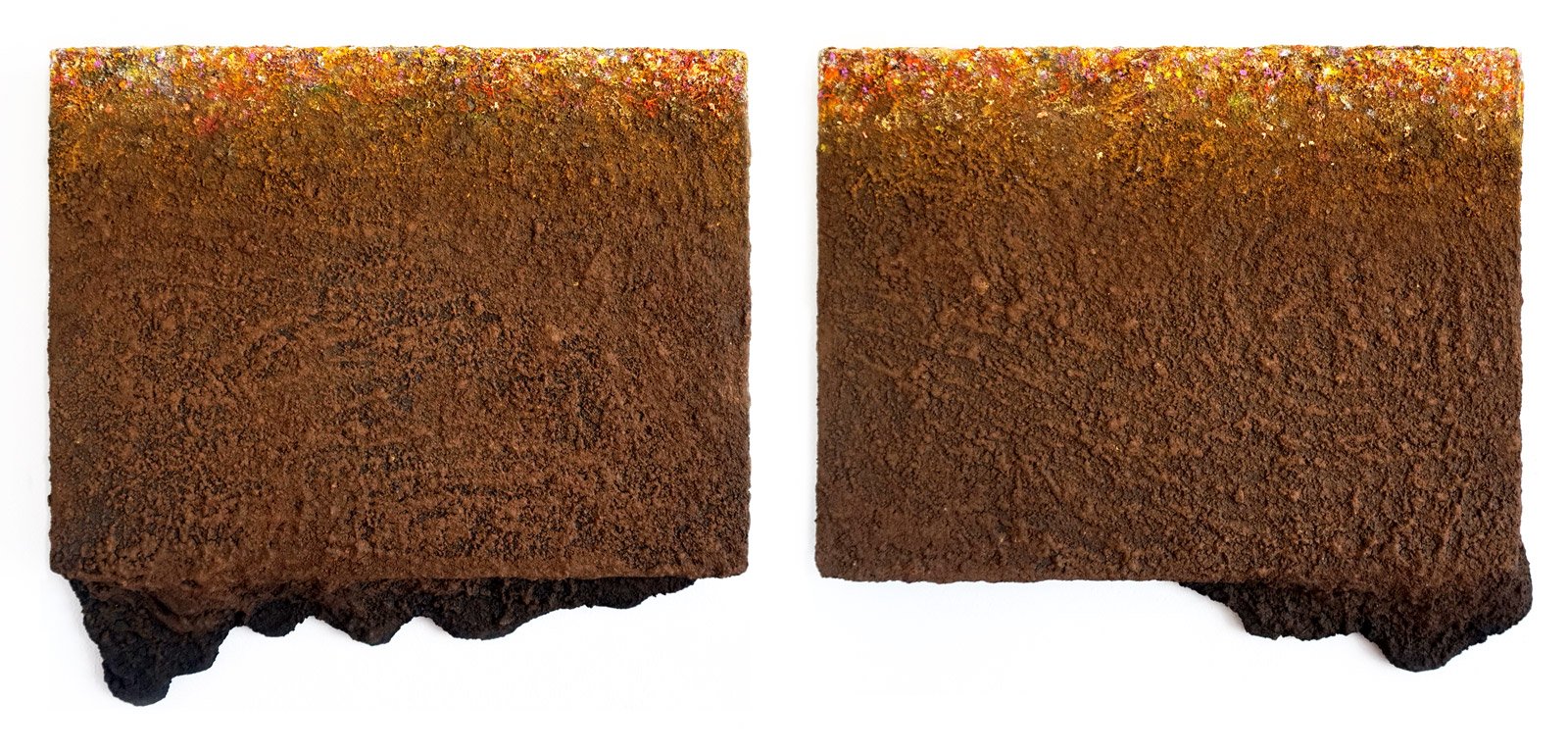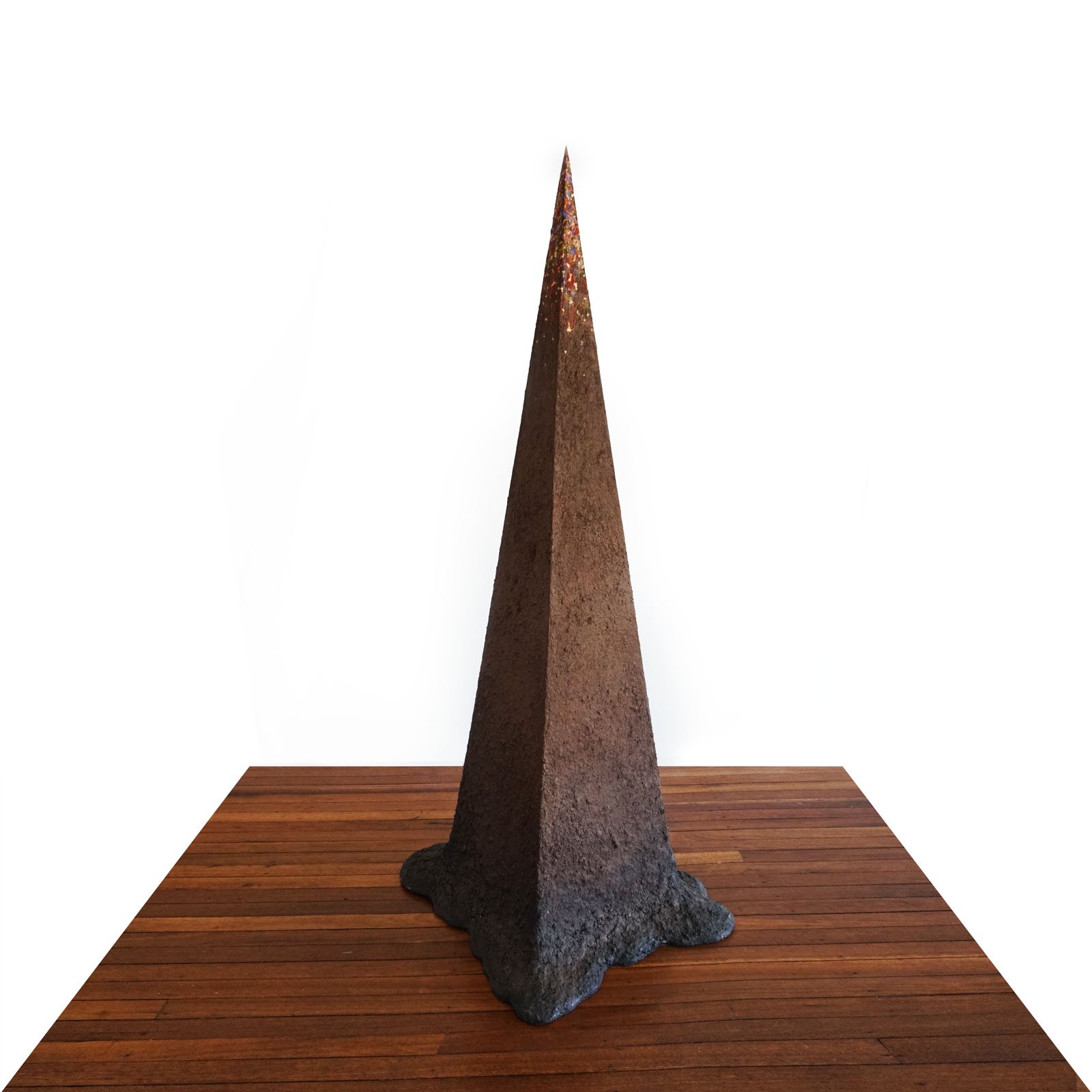Cintamani and the Golden Pixel
1st Avenue Gallery, Sawtell NSW Australia, March 2016
Artist Statement
Revelation and the construction of conceptual narratives is what we use to define ourselves, and our place in the cosmos. These dual concepts hold the central interest in my work. We interface with the world around us with the stories we use to describe it, and depending upon what narrative we accept as ‘truth’, our vision of reality will change.
 Prasraya avanatam - Mountains of Humility Act2
2016
Myocum Earth, Vrindavan dust, acrylic, faux gold leaf and brass on plywood
670 X 1370 X 70 mm each
Prasraya avanatam - Mountains of Humility Act2
2016
Myocum Earth, Vrindavan dust, acrylic, faux gold leaf and brass on plywood
670 X 1370 X 70 mm each
The compounded efforts of the artists from the past 150 years has broken free the artist’s toolbox and given practitioners an open palette in the creation of art. It’s an exciting privilege to be able to move across a spectrum of styles, mediums and subjects to explore underlying themes and stories as we navigate a culture saturated with visual content.
As an artist working across this spectrum, painting has and will always be my primary fascination. I find the capacity to transform the Earth (which has been refined into pigment and paint) into images…to be magical. The artist can convince the viewer of any reality presented to them. Not just objects of the external world but refined feelings from the inner plane.
 Cintamani - Deluge of Divinity - Act 1 I, II
2016
Myocum Earth, Vrindavan dust, acrylic, faux gold leaf and brass on plywood
670 X 1370 X 70 mm each
Cintamani - Deluge of Divinity - Act 1 I, II
2016
Myocum Earth, Vrindavan dust, acrylic, faux gold leaf and brass on plywood
670 X 1370 X 70 mm each
 Cintamani - Descent of the Divine Reality
2015
>Myocum Earth, Vrindavan dust, acrylic, faux gold leaf and brass on plywood
2030 x 800 x 800 mm
Cintamani - Descent of the Divine Reality
2015
>Myocum Earth, Vrindavan dust, acrylic, faux gold leaf and brass on plywood
2030 x 800 x 800 mm
 Cintamani - Deluge of Divinity - Act 2 I, II, III, IV
2016
Myocum Earth, Vrindavan dust, acrylic, faux gold leaf and brass on plywood
670 X 1370 X 70 mm each
Cintamani - Deluge of Divinity - Act 2 I, II, III, IV
2016
Myocum Earth, Vrindavan dust, acrylic, faux gold leaf and brass on plywood
670 X 1370 X 70 mm each
The core of this transformation is mark making – the primordial statement. I exist, I was here, left in the fabric of matter, a vibration of consciousness and a frozen moment of revelation…communicating across time. The simple mark has much capacity to express feelings and ideas. These marks can be refined into patterns and transformed into words or images. Laced together these cluster of marks form stories and through these stories we define our place and the world.
The primary narrative of the works presented in this exhibition, continue my exploration of portraying the divinity within the Earth as the divine substance of Cintamani. The divine gemstone Cintamani is described by the Vaisnava Sages as a spiritually dynamic and fluid wish filling substance of infinite variation that responds to desire and conscious intent.
Cintamani is not a substance of this world that can be acquired by force but an ornament of consciousness that descends from a plane of reality described in the Vedas as the Paravyoma. A reality finer and more conscious than our very own self, whose contact creates intense feelings of humility and gratitude for this gift of life.
Currently, through the progress of technology we are moving to a physical replication of this type of relationship by creating a digitally integrated environment that responds to the desire and needs of the inhabitants as we seek to manifest the qualities of the inner world into a measured, timed and tactile experience. To make this reality the world is being mapped into a spatial index. With machines plotting reality into a grid where we will no longer interact with it directly with our senses but through this interface of a pixelated reality. The digital grid existing in the collective of the human minds.
It is my observation that the modern narratives used to describe the world around us; in their attempt to sideline religious control over the advancement of knowledge has diminished our relationship of honouring the sacred forces of life within and around us. These new narratives have allowed the rapid advancement of technology but the lack of education of the sacredness of life has led to repercussions we witness everyday with the unhealthy effect of the human transformation of the environment.
This act of relating to the sublime is an inherent quality of being human and drives us to make art and create objects of beauty. To ignore this is like a fish disbelieving in the existence of water because of its un-seeable quality. This body of work attempts to reconcile this process of gridification with the vision of the inviolable truth. In some works faceted conceptual narratives are housed in allegorical landscapes and other works I have tried to eliminate the pareidolic and metaphorical possibilities of the subject completely by using the texture of the Earth and a myriad of colours to show the divine qualities of the Earth herself. To present to the viewer in the most simplistic narrative,to just look at the Earth, see the beauty and acknowledge its sacredness without the visual interface of any cultural story. Earth and marks, left in adoration, in worship.’
Isha Black March 2016
 Cintamani - Spatial Index
2016
Ewingsdale Earth, Panihati dust and acrylic on plywood
420 x 420 x 420 mm
Cintamani - Spatial Index
2016
Ewingsdale Earth, Panihati dust and acrylic on plywood
420 x 420 x 420 mm
List of Works
- Cintamani - The Golden Pixel - Act 1, I-IX 2016 Acrylic, Myocum Earth, Vrindavan dust, faux gold leaf on plywood 275 x 275 mm each
- Cintamani - The Golden Pixel - Act 2, I-IX 2016 Acrylic, Myocum Earth, Vrindavan dust, faux gold leaf on plywood 275 x 275 mm each
- Cintamani - The Golden Pixel - Act 3, I-IX 2016 Acrylic, Myocum Earth, Vrindavan dust, faux gold leaf on plywood 275 x 275 mm each
- Cintamani - Decent of the Sacred Reality 2016 Myocum Earth, Vrindavan dust, acrylic, faux gold leaf and brass on plywood 2030 x 800 x 800 mm
- Cintamani - Deluge of Divinity - Act 1 I 2016 Myocum Earth, Vrindavan dust, acrylic, faux gold leaf and brass on plywood 670 x 1370 x 70 mm
- Cintamani - Deluge of Divinity - Act 1 II 2016 Myocum Earth, Vrindavan dust, acrylic, faux gold leaf and brass on plywood 670 x 1370 x 70 mm
- Cintamani - Deluge of Divinity - Act 2 I 2016 Myocum Earth, Vrindavan dust, acrylic, faux gold leaf and brass on plywood 670 x 1370 x 70 mm
- Cintamani - Deluge of Divinity - Act 2 II 2016 Myocum Earth, Vrindavan dust, acrylic, faux gold leaf and brass on plywood 670 x 1370 x 70 mm
- Cintamani - Deluge of Divinity - Act 2 III 2016 Myocum Earth, Vrindavan dust, acrylic, faux gold leaf and brass on plywood 670 x 1370 x 70 mm
- Cintamani - Deluge of Divinity - Act 2 IV 2016 Myocum Earth, Vrindavan dust, acrylic, faux gold leaf and brass on plywood 670 x 1370 x 70 mm
- Cintamani - Spacial Index 2016 Ewingsdale Earth, Panihati dust and acrylic on plywood 420 x 420 x 420 mm
- Cintamani - Spacial network I 2016 Ewingsdale Earth, Mullumbimby Earth, ethernet cable and acrylic on plywood 230 x 230 x 230 mm
- Cintamani - Spacial network II 2016 Ewingsdale Earth, Mullumbimby Earth, ethernet cable and acrylic on plywood 230 x 230 x 230 mm
- Cintamani - Spacial network III 2016 Ewingsdale Earth, Mullumbimby Earth, ethernet cable and acrylic on plywood 230 x 230 x 230 mm
- Cintamani - Pixelated Goddess - I 2016 Mullum Earth and acrylic on wood 30 x 30 x 30 mm
- Cintamani - Pixelated Goddess - II 2016 Mullum Earth and acrylic on wood 60 x 60 x 50 mm
- Cintamani - Pixelated Goddess - III 2016 Mullum Earth and acrylic on wood 60 x 90 x 50 mm
- Cintamani - Pixelated Goddess - IV 2016 Mullum Earth and acrylic on wood 90 x 90 x 50 mm
- Cintamani - Pixelated Goddess - V 2016 Mullum Earth and acrylic on wood 90 x 160 x 50 mm
- Cintamani - Pixelated Goddess - VI 2016 Mullum Earth and acrylic on wood 150 x 150 x 60 mm
- Cintamani - Pixelated Goddess - VII 2016 Mullum Earth and acrylic on wood 120 x 210 x 70 mm
- Cintamani - Pixelated Goddess - VIII 2016 Mullum Earth and acrylic on wood 120 x 330 x 90 mm
- Cintamani - Pixelated Goddess - IX 2016 Mullum Earth and acrylic on wood 220 x 460 x 110 mm
- Praśraya-avanatam - Mountains of Humility - Act 1, I 2016 Acrylic on canvas 250 x 200 mm
- Praśraya-avanatam - Mountains of Humility - Act 1, II 2016 Acrylic on canvas 250 x 200 mm
- Praśraya-avanatam - Mountains of Humility - Act 1, III 2016 Acrylic on canvas 250 x 200 mm
- Praśraya-avanatam - Mountains of Humility - Act 1, IV 2016 Acrylic on canvas 250 x 200 mm
- Praśraya-avanatam - Mountains of Humility - Act 1, V 2016 Acrylic on canvas 250 x 200 mm
- Praśraya-avanatam - Mountains of Humility - Act 1, VI 2016 Acrylic on canvas 250 x 200 mm
- Praśraya-avanatam - Mountains of Humility - Act 2 2016 Acrylic on plywood 1020 x 1520 mm
- Madhukari-vahnigarbha - Chamber of the Heart 2016 Acrylic on canvas 910 x 1215 mm Diptych
- Brahmāṇḍa bhramite - Harinama Cintamani Across the Universes 2016 Mixed media on plywood 1020 x 720 mm Triptych
- Mana-nava-megha - Search for the Everfresh Act 1 2016 Acrylic on plywood 890 x 1156 mm
- Mana-nava-megha - Search for the Everfresh Act 2 I 2016 Acrylic on plywood 177 x 240 mm
- Mana-nava-megha - Search for the Everfresh Act 2 II 2016 Acrylic on plywood 177 x 240 mm
- Mana-nava-megha - Search for the Everfresh Act 2 III 2016 Acrylic on plywood 177 x 240 mm
- Mana-nava-megha - Search for the Everfresh Act 2 III 2016 Acrylic on plywood 177 x 240 mm
- Kali Kukkura - World Self Haters Dogs of the Death Wish I 2016 Acrylic on plywood 240 x 177 mm
- Kali Kukkura - World Self Haters Dogs of the Death Wish II 2016 Acrylic on plywood 240 x 177 mm
- Kali Kukkura - World Self Haters Dogs of the Death Wish III 2016 Acrylic on plywood 240 x 177 mm
